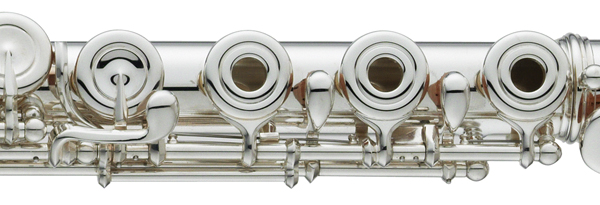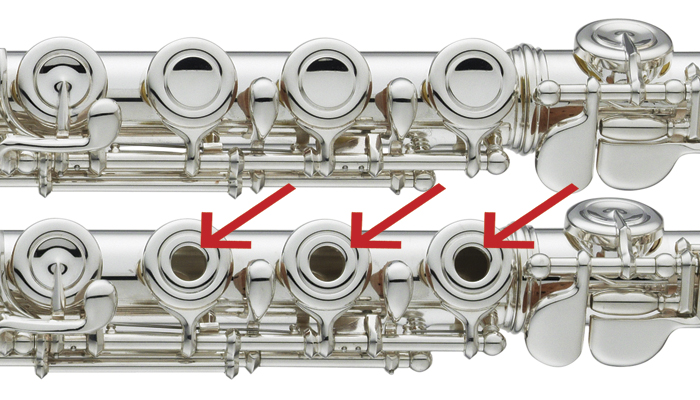Flute Features – Open Hole Keys
24th January 2019A major factor to consider when upgrading your flute is whether or not to buy an open or closed hole flute. Most student flutes are only available with closed holes, whereas intermediate and professional models can be bought with either closed or open holes. Is one option inherently better than the other? Today we take a closer look at why the open holed flute might be right for you.
Closed hole keys, also referred to as plateau keys, are standard for student model flutes. The main reason for this is that open hole keys – also known as ring keys or ‘French’ keys – are notoriously difficult for little hands to use! A younger student may find that their fingers don’t stretch to cover open hole keys. Likewise, even adult learners may be put off by the exact finger placement require for open hole keys.
Whilst open holed instruments are associated more with advanced students and professionals, there are still many players in the professional circuit who prefer using closed hole flutes. Once at a certain level, teachers may ask their students to consider open holes. But this doesn’t mean you have to play with open holes to be a pro flautist. Everyone is different, so if you prefer closed holes rest assured that this doesn’t mean you’re a ‘bad’ player.
Below are a few points to consider when looking at open hole flutes. These often form the argument of using open holes over closed.
Hand Position
Advancing players may find open holes encourage a better hand position, and by extension playing posture. This does present the issue of an adjustment period! You might consider using open hole plugs placed in such a way to feel the open hole without fear of of your fingers ‘missing the target’. Alternatively, Powell Plug-Os provide a metal plateau over open holes to feel like closed hole. Simply remove when you feel confident to do so!
A Lighter Instrument
It probably goes without saying that with less material used for the mechanism, an open hole flute is lighter than its closed hole counterpart. This could mean less strain on the wrists and shoulders – although some may find the difference to be negligible. It’s also been argued that a lighter instrument improves the over all resonance of the instrument; less material = freer vibrations. You might not notice at first, but the difference is there!
Extended Techniques
As a flautist, the chance to explore a range of extended techniques is the main reason I love playing an open hole flute!
- Tone Flexibility
- I’m not just talking about tone colours, but about the way open holes let you manipulate tone and pitch. Most notably, like with the clarinet, open holes allow a flautist to perform bends, scoops and glissandi. Techniques like these are otherwise impossible on a closed hole flute.
- The above techniques are commonly used in jazz styles, folk genres, contemporary compositions and in improvisation.
- You can also emulate the sounds of ethnic flutes, like Chinese dizi. Using alternate fingerings, one can achieve the ‘wooden’, ‘hollow’ or ‘breathy’ quality found in many traditional and world flutes.
- Microtones
- Alternate fingerings also allow flautists to perform microtones – the ‘notes between the notes’!
- Multiphonics
- Whilst some are possible on closed hole flutes, the mechanism of an open hole flute simply allows for more fingering combinations. For example, you could depress a key without closing the hole. This allows the airflow to vent differently, creating a different combination of harmonics. Manipulate this in the right way and you have a whole arsenal of multiphonic capabilities!
There are many composers who use extended techniques in their repertoire. Exploring pieces, such as Spiral Lament by Ian Clarke, can help you create a whole new tonal palette!
Alternate Fingerings
Of course, as well as extended technique, alternate fingerings also allow for an extension of standard technique. Open hole flutes provide finger combinations that can ensure more stable tuning for notes in the upper register.
Each flute is different, so whilst you can use fingering charts as a guide the best thing to do is have a play around to see what works for you.
Do I need an open hole flute?
All of the above may make an open hole flute seem like ‘the thing to have’ – but in standard repertoire, it isn’t totally necessary. People see open holes as a goal, or something to achieve with progress, in the same way young clarinet and saxophone players will want to ‘graduate’ to harder strength reeds. In either case, it’s down to preference. Plenty of excellent players, be they students, amateurs or professionals, use closed hole flutes.
So if you’re looking at upgrading your flute, the best thing to do is to come in and have a go! All of our staff are happy to help guide you through the process of finding a new flute perfect for you.
Some open hole flutes available include the Azumi AZ-Z2RE, the Yamaha YFL-372GL with gold lip plate, and Pearl 659RE Dolce.
Also available are closed hole models, such as the Miyazawa MJ-101SE, the Pearl 665E Quantz Forza, and Altus 907E – all of which are popular for the upgrading player.

